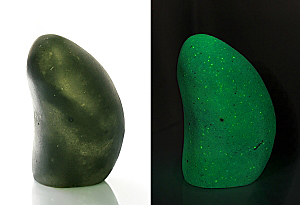The term "Ye Ming Zhu" is used (in a manner similar to that of the term "Jade") not for a single mineral, but for a whole range of different minerals and artificial products. Their special feature is, that they show the special optical property of phosphorescence when exposed to daylight.
The list of natural minerals showing phosphorescence under rare circumstances is long: apatite, calcite, celestine, diamond and fluorite belong to it as well as garnet, magnesite, opal, spinel, spodumene and zircon. However, these minerals only phosphoresce if they contain certain impurities. As less than 1% copper (Cu) or silver (Ag) in Sphalerite (zinc blende, zinc sulphide), generates a yellowish-green glow. If it is contaminated (doped) with europium (an element of the Rare Earths group), it achieves a significantly longer (and brighter) phosphorescence time.
Alkaline Earth Aluminates contaminated with Rare Earth elements can develop phosphoresce for seconds to minutes. Especially the Rare Earth elements: Lanthanum (La), Europium (Eu) and Dysprosium (Dy) are able to interact with elements of the host mineral - e.g. Calcium (Ca), Strontium (Sr), Barium (Ba) and Aluminium (Al). They store the energy of the light, which is released with a certain delay as a visible glow.
According to the research of the EPI laboratory, several types of "Ye Ming Zhu" are offered on the Internet:
"Ancient Ye Ming Zhu"
A natural mineral that is stimulated to phosphoresce by light in the visible spectra. As these can be completely different natural minerals, no general characteristics such as hardness, density or refraction index can be named. It is necessary to check in detail which mineral is involved. The most common natural mineral showing phosphoresce is fluorite. These natural minerals are very rare indeed.
"Modern Ye Ming Zhu"
Under this term all artificial products (plastics, glasses, ceramics) which show phosphorescence for minutes to hours due to certain additives are summarized. They are often used for garden or interior decoration or in safety areas (warning signs etc.).
"Glowing stones" are also offered in DIY stores and on the Internet, usually at prices of a few euros per kg.
In the 1960s and 1970s such stones were still produced with the help of radioactive elements (e.g. radium). This practice has since been banned and the hazardous elements have been replaced by non-radioactive elements.
The fear of radioactiv polution may be one reason why phosphorescent materials are rarely found in jewellery. Plastics look too cheap to be accepted as jewellery. In addition they are too soft (Mohs hardness of 2-3). The situation is different with glasses and ceramics. Phosphorescent glasses have a Mohs hardness of 5-6, ceramics even up to 8.
"Celestial Ye Ming Zhu"
This designation is given to phosphorescent ceramics which are offered as grounded, tumbled or set articles for esoteric purposes. Similar to the artificial glass products, marketed as »Andara Crystal«, an internet community is cultivated around the artificial Ye Ming Zhu product, which "exchanges experiences and offers teachers, traders and ambassadors a platform to connect and exchange ideas".
[Ref.: http://celestiallegacy.com/what-is-ye-ming-zhu/]
Conclusion
The term "Ye Ming Zhu" refers to substances that show the light effect of phosphorescence after being exposed to daylight. Natural minerals that show this light effect are existing. Since they need a well dosed amount of certain rare elements to show the light effect clearly, they are rarities in the mineral trade.
In general phosphorescent materials are artificially manufactured products made of plastic, glass or ceramic. Radioactivity we have not found in any of these products.




